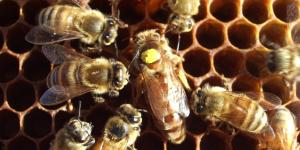Most Common Diseases in Rabbits



See files for Rabbits
If you have a rabbit or are thinking of adopting one, you must be clued up on all their necessities to that your rabbit is happy and healthy. We must take into account that if our domestic rabbit is well cared for and is in good health, they can live up to 8 years. Rabbits, like any other animal are prone to specific diseases and therefore, these health problems in rabbits need to be prevented.
So, if you want to enjoy the maximum number of years with your long-eared friend keep reading this AnimalWised article. We will show you the most common diseases in rabbits so you will be able to detect them promptly and take your pet to the vet.
- Most common health problems in rabbits: prevention
- Common viral diseases in rabbits
- Fungal diseases in rabbits
- Skin disease in rabbits: external parasites
- Parasites in rabbits: internal
- Genetic diseases in rabbits
- Zoonotic diseases in rabbits
- Neurological diseases in rabbits
- Most common health problems in rabbits
- Is my rabbit dying?
Most common health problems in rabbits: prevention
Rabbits can suffer from a range of diseases from different origin like any living thing. We will classify and describe the most common diseases according to their origin, such as bacterial, fungal, viral, parasitic, hereditary and other health problems.
Most rabbit diseases are specific to them, i.e. they are not transmitted between different animal species. So if we have another animal living with our bunny we do not have to worry about contagions of serious diseases.
In order to prevent the great majority of diseases and common problems, we must do the following:
- Follow the vaccination schedule advised by our vet
- Maintain good hygiene
- Provide healthy and appropriate food
- Provide exercise along with a good rest
- Make sure our rabbit is exempt from stress
- Frequently check their body and coat
- and observe their behavior. Any small change that seems strange to you is worth a visit to the vet.
By following these guidelines we will easily avoid health problems and in case they happen to occur we will detect them early. This will make the recovery of our furry friend faster and more effective. Now let's move onto the most common diseases of rabbits according to their origin.

Common viral diseases in rabbits
Common viral diseases in rabbits include:
- Rabies: This viral disease is widespread throughout the world, but in some countries it is already eradicated, since effective vaccination is in fact mandatory in many parts of the world. Many mammals, including Oryctolagus cuniculus, are affected by this disease. If we try to have our rabbit vaccinated daily, while avoiding possible contact with animals that seem to be sick with rabies, we can rest easy. Yet, we must know that there is no cure and it is best to avoid prolonging the suffering of the victim.
- Haemorrhagic disease of the rabbit: This disease is caused by a calicivirus and is transmitted very quickly. It is also contagious both directly and indirectly. The routes of entry of this viral infection are nasal, conjunctival and oral. The most common symptoms are nervous and respiratory signs, in addition to anorexia and apathy. Because this virus manifests very aggressively causing seizures and nosebleeds, affected animals usually die within a few hours after the onset of the first symptoms. Therefore, it is best to prevent this disease by following the vaccination schedule. Generally, an annual bivalent vaccine is administered to rabbits, which covers this disease and myxomatosis at the same time.
- Myxomatosis: The first symptoms appear after 5 or 6 days after the infection. There is a lack of appetite, inflammation of the eyelids, inflammation of the lips, ears, breasts and genitals, and swelling of the nose with clear nasal discharge and pustules around the mucous membranes. There is no treatment for this disease so it is best to prevent it with the appropriate vaccines in spring and summer. Summer being the time of year with more risk. The vectors or transmitters of the virus that cause this disease are hematophagous insects (they feed on blood), such as mosquitoes, some flies, ticks, fleas, lice, horseflies, etc. In addition it can also be spread by contact with other sick individuals. Sick animals die between the second and fourth week after infection.

Fungal diseases in rabbits
- Pasterelosis: This disease is of bacterial origin and can be produced by two different types of bacteria, for pasteurella and for bordetella. The most common factors that favor this bacterial infection are the dust of dry food that we give our rabbits, the environment and climate of the place they live and the stress they may have accumulated. The most common symptoms are sneezing, snoring and a lot of nasal mucus. It can be treated with specific antibiotics which will be highly effective if the disease is not very advanced.
- Pneumonia: In this case the symptoms are also respiratory, resulting in sneezing, nasal mucus, snoring, coughing, etc. Therefore, it is similar to pasterelosis but turns out to be a much deeper and more complicated bacterial infection that reaches the lungs. Their treatment will also be with specific antibiotics.
- Generalized abscesses: The most common abscesses in rabbits are lumps under the skin that are filled with pus and are caused by bacteria. We will have to go to the vet to start a treatment as soon as possible and we must perform cures to eliminate the bacterial infection and the abscess itself.
- Diseases in rabbit eyes- Conjunctivitis and eye infections: Common eye diseases in rabbits. They are produced by bacteria on the eyelids of rabbits. The eyes become inflamed and there are abundant ocular secretions. In addition, in more severe cases the hair around the eyes is stuck, the eyes are filled with secretions that prevent the animal from opening its eyes and they can even turn into pus. Conjunctivitis may be of non-bacterial origin, causing irritation from different allergens such as household dust, tobacco smoke or dust that can be produced in its bed if it contains very volatile particles such as sawdust. We must apply specific eye drops that our trusted vet prescribes for as long as they tell us or even more.
- Pododermatitis or plantar calluses: Also known as ulcerated tarsal disease. It occurs when the environment of the rabbit is wet and the floor of the cage is not the most suitable. Wounds are produced that are infected with bacteria that end up producing the pododermatitis in the legs of the affected rabbits. It is a very contagious disease as these bacteria are lodged at almost any point of a small wound and even cracks in the skin that have not yet expanded.
- Rabbit ringworm: It is produced by a fungus that affects the skin of rabbits. It reproduces at high speed by spores, so if it manifests itself. It is difficult to control the contagion to other individuals that coexist. There are areas without hairs that are rounded and crusted on the skin, especially on the face of the animal.
- Diseases in rabbit ears- middle ear and inner ear: These complications are caused by bacteria and greatly affect the organ of equilibrium that is in the ear, so the most notable symptoms are loss of balance and rotation of the head to the side, depending on which ear is affected. These symptoms usually manifest when the disease is already advanced so we realize it usually late and therefore almost no treatment is usually effective.
- Coccidiosis: Coccidiosis is one of the most deadly diseases in rabbits. Coccidia are microorganisms that attack from the stomach to the colon. These microorganisms live in equilibrium in the digestive system of the rabbit in a normal way, but when there are very high levels of stress and important defenses deterioraite, coccidios then multiply uncontrollably and adversely affect the rabbit. The most common symptoms are hair loss along with digestive disorders such as excess gas and continuous diarrhea. In the end the affected rabbit stops eating and drinking and ends up dying.

Skin disease in rabbits: external parasites
Parasitic diseases in rabbits include:
- Scabies: Scabies are produced by mites that form tunnels in the various layers of the skin, even reaching the muscles, of the infested animal. There they reproduce and lay their eggs. These eggs hatch out new mites that produce more pruritus, wounds, crusts, etc. In the case of rabbits there are two types of scabies, the one that affects the skin of the body in general and the one that only affects the ears. Scabies are highly contagious among rabbits and are caused by contact with infested animals. It is prevented and treated with ivermectin.
- Fleas and lice: If our rabbit spends part of the day outside in the garden or in contact with dogs or cats that do come out, they are likely to end up having fleas and lice. We must avoid this by deworming our pets that can catch more easily like cats and dogs. We must also use some antiparasitic specific for rabbits that our specialist veterinarian prescribes. In addition to problems of excessive scraping by the pruritus produced by these parasites, we must think that they are hematophagous and that therefore they feed on the blood of our pet with their sting. This is how they transmit many diseases such as myxomatosis and Tularemia.
In order to prevent parasites in rabbits, make sure that you follow a rabbit vaccination schedule.

Parasites in rabbits: internal
- Diarrhea: Diarrhea is very common in rabbits of any age, but specifically in baby rabbits. These small mammals are very delicate and sensitive in their digestive tract. Among the most common causes is abruptly changing their diet and not washing fresh food properly. Therefore, we must make sure that we have thoroughly washed any fresh food with water before giving it and in case of having to change the diet for any reason, we must do it gradually. First mixing the diet that we want to remove with the new one and gradually introduce it. Thus their digestive system will adapt properly to the change without developing any issues along the way. For more, take a look at our article where we discuss causes and treatment of diarrhea in rabbits.
- Coliform infection: This infection is a secondary infection by opportunistic parasites. When our rabbit already suffers from, for example, coccidiosis, this disease easily allows secondary infections. Coliform infection in rabbits is due to escherichia coli and the main symptom and the most serious problem it produces is continuous diarrhea. If it is not treated in time with enrofloxacin injection or diluted in the water taken by the rabbit, it can end up resulting in death.

Genetic diseases in rabbits
Hereditary rabbit diseases include:
- Dental overgrowth or shortening malformation of the upper and / or lower jaw: It is a hereditary problem that occurs due to the excessive growth of the teeth, either the upper or lower incisors. It ends up displacing the mandible or maxilla backwards with spacing issues. This means our rabbit cannot feed well and in severe cases can die from starvation if we do not take them regularly to the vet to cut or trim their teeth. Likewise, we must provide food when they find it difficult to eat themselves. Learn more about how to act in the case of abnormal growth in your rabbit's teeth.

Zoonotic diseases in rabbits
Zoonotic diseases refer to diseases transmitted from rabbits to humans (or animals to humans). But what diseases can you get from rabbits? These include:
- Hantavirus: (hantavirus pulmonary syndrome) is a virus contagious through feces. Avoiding this virus can be done through proper precautions when in contact with your rabbit’s feces.
- Leptospirosis: is a bacterial infection that causes diarrhea in rabbits. Symptoms of leptospirosis, include: fever, headache, vomiting, jaundice and abdominal pain.
- Lymphocytic choriomengitis: this viral infection is rhodent borne and can be transmitted through urine and feces.
- Tularemia: This bacterial disease is very serious since it does not present symptoms, only that the affected animal stops eating. It can only be diagnosed with laboratory tests since we cannot rely on more symptoms or tests that can be done at the veterinary clinic at the time. Without eating any food the affected rabbit can die between the second and the fourth day. This disease is linked to fleas and mites. For more, we recommend reading our article where we tell you everything you need to know about tularemia in rabbits.
Neurological diseases in rabbits
Neurological diseases are very common in companion rabbits. Common neurological diseases in rabbits can be linked to bacterial infections and include:
- Head tilt: wry neck in rabbits.
- Paralysis: often caused by trauma to the spinal cord.
- Pregnancy Toxemia: although rare, it can be fatal
Most common health problems in rabbits
- Stress: Stress in rabbits can be caused by several problems in their environment. For example by feeling very alone or by lack of affection, by the changes in their environment and the changes of home and companions with whom they live. Also, of course, if they do not have enough room to live, have a bad diet and do little exercise, they will become stressed. Make sure to recognize these signs of stress in rabbits.
- Colds: Rabbits also get cold from exposure to excessive air currents and moisture. They occur more frequently when our rabbit is stressed or under defensive. The symptoms are sneezing, abundant nasal discharge, swollen and watery eyes, etc.
- Swollen wounds and inflammation of the skin: It is easy that in a cage, even a few hours of the day, we will sometimes see that our rabbit has some inflamed area or even some wound. We must be attentive and check their body everyday, because these swells and wounds often become infected very quickly and eventually ooze pus - greatly weakening the health of our rabbit. They could even end up dying from an infection.
- Invagination of the eyelids: This is a problem in which the eyelids bend inward, which in addition to being a great nuisance for our pet, ends up producing irritations and suppurations in the tearducts. If they get infected it can produce blindness.
- Hair loss and ingestion of this: Hair loss in rabbits is usually due to stress and lack of some nutrients and vitamins in their daily diet. For these same reasons, they often eat their hair that falls off them. Therefore, if we detect that this happens to our friend we should go to the vet to check what may be wrong with their diet or what may be stressing them and thus rectify the problem.
- Red urine: This is a deficit in the feeding of the rabbit that causes this color in the urine. We should check their diet and rebalance it, as it is likely that we are giving them excess green vegetables or lacking some vitamins or fiber. We should not confuse ourselves with blood in urine as this will be a more serious problem that requires immediate action by the veterinarian.
- Cancer: The cancer most frequently affected by rabbits is that of the genitals, whether male or female. For example, in the case of rabbits, those who are not sterilized are 85% more likely to have uterine and ovarian cancer at the age of 3 years. At 5 years, this risk increases to 96%. Sterilized rabbits, in addition to living in adequate and healthy conditions, can live with us between 7 and 10 years without problems.
- Obesity: In domestic rabbits, obesity or overweightness are increasingly common due to the type and amount of food they receive and the little exercise they do daily. Find out on here how much food a rabbit should eat.
- Heatstroke: Rabbits are more accustomed to the cold than to the heat, because they come from areas with lower temperatures than high throughout the year. This is why some breeds of rabbits tolerate well temperatures up to -10ºC if they have some shelter, but for them temperatures that are around 30ºC are too high. If they are exposed to them without water or a cool place to regulate their temperature, they will suffer a heat stroke and can die in a short time by cardiac arrest. They may die of dehydration, but they may have reached cardiac arrest earlier. The easiest symptoms to see are the continuous panting and stretching all four legs leaving the belly in contact with the ground to cool them down.

Is my rabbit dying?
It is important to note that if you believe your rabbit is ill or suffering from any of the above mentioned disease, you take it to the veterinarian immediately! If you want to know more about the signs of a dying rabbit, watch our video below:

This article is purely informative. AnimalWised does not have the authority to prescribe any veterinary treatment or create a diagnosis. We invite you to take your pet to the veterinarian if they are suffering from any condition or pain.
If you want to read similar articles to Most Common Diseases in Rabbits, we recommend you visit our Other health problems category.












